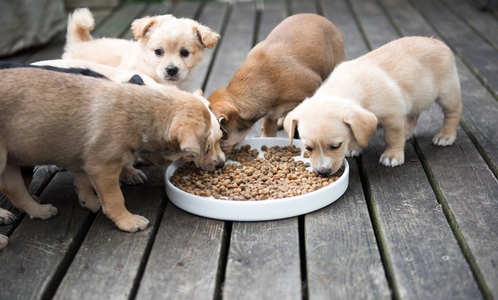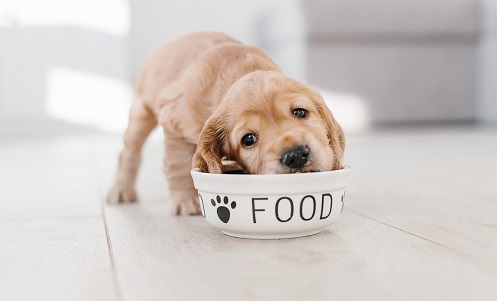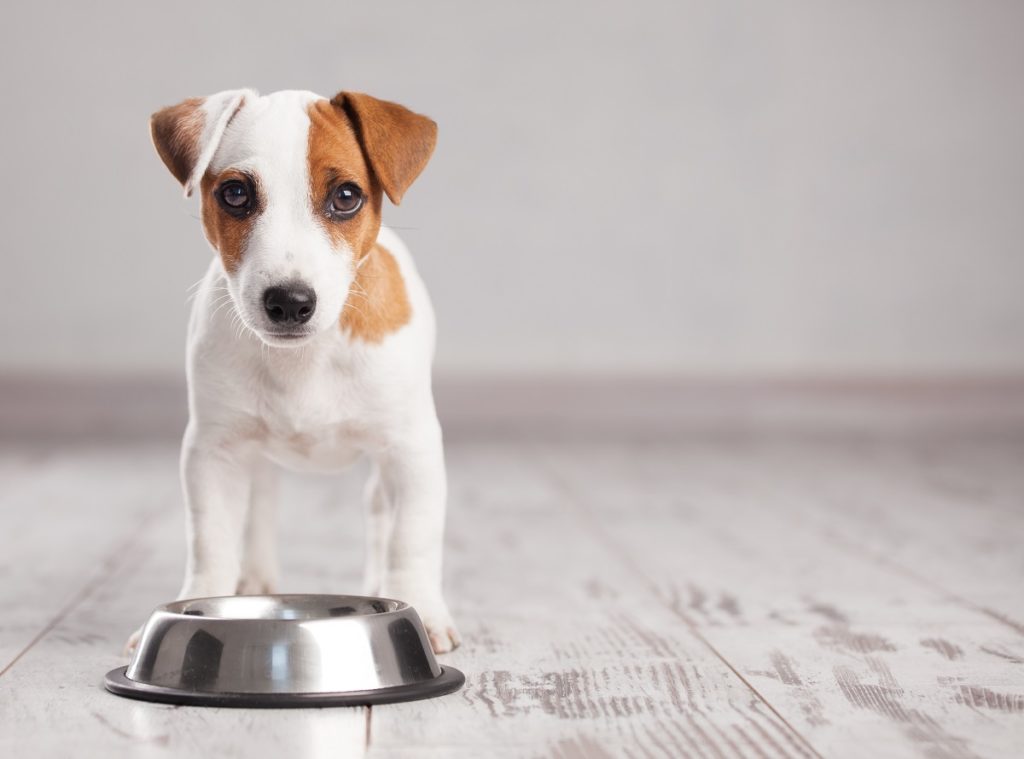From the time an adorable puppy enters the world, he has one driving goal: to eat. Most people know that keeping a pup on his mother’s milk is the best choice for growing up healthy, but what happens after that? Knowing when to switch to adult dog food for your puppy isn’t always an intuitive decision – and a loving, devoted puppy owner doesn’t want to get it wrong. What’s the best way to tell that a puppy is ready to start chowing down with the big dogs and leave his puppy chow behind? This article will discuss some commonly- asked questions that may be especially helpful for first-time puppy parents.
Like Human Children, It Depends
Before getting started, it’s important to note that there are a lot of differences between adult dog food vs. puppy food. While pet owners can generally expect to make the big switch in their pup’s food bowl at about a year to a year and a half old, his breed will factor into it heavily. For small to medium-breed dogs (defined as an expectation he’ll weigh less than 50 pounds fully grown), the target will be closer to the year mark. If he’s a bigger breed or has a larger breed in his genetics, he’ll likely remain in his puppyhood a little longer, as all that growing requires extra food energy for a longer period of time. Certain breeds may also have additional considerations, such as nutrients needed to keep their coat shiny, or in some cases, a pup may require specialty allergen-free food – so be sure to consult with a trusted vet to determine which dog food brand has the correct canine nutritional needs that will work best for him.
 Even if a healthy growing puppy looks as if he can handle the size, crunch, or taste of adult dog food, it doesn’t necessarily mean it’s a good choice for him. Consider human toddlers and their fascination with the foods mom or dad eat: they’ll be curious to taste them, but those foods won’t have the nutrient-dense makeup they need to grow strong; in other cases, their digestive system (and even lack of teeth) may not be quite ready for them. Similarly, this logic also applies to young canine companions: although he’ll most likely want anything (and everything) that smells remotely appealing to his super-sensitive nose, it also means his pet parents will need to stand firm and be the voice of reason – even if he’s a particularly convincing beggar.
Even if a healthy growing puppy looks as if he can handle the size, crunch, or taste of adult dog food, it doesn’t necessarily mean it’s a good choice for him. Consider human toddlers and their fascination with the foods mom or dad eat: they’ll be curious to taste them, but those foods won’t have the nutrient-dense makeup they need to grow strong; in other cases, their digestive system (and even lack of teeth) may not be quite ready for them. Similarly, this logic also applies to young canine companions: although he’ll most likely want anything (and everything) that smells remotely appealing to his super-sensitive nose, it also means his pet parents will need to stand firm and be the voice of reason – even if he’s a particularly convincing beggar.
Making The Switch From Puppy Food
Once a pooch has grown into himself a bit, his people may be eyeing the calendar and wondering if it’s time to finally pick up the adult dog food. While there’s a temptation to switch over all at once to reinforce the new chow, this can be a very troublesome time for his stomach. It’s important to ease him into the new food to prevent canine diarrhea or vomiting, or potential sluggishness from nutritional changes. Below, some helpful tips:
- Use a small handful of the new food over a few days as “training treats” to introduce & acclimate him
- Don’t completely replace his food at first – use a 50-50 mixture of new and old and gradually increase the proportion of new food each day
- Don’t switch his food right away if there are other stressors present – a move, a long car ride, etc. Anxiety can falsely make it seem like the food is causing issues
- Note his energy level and any changes in behavior – if he doesn’t seem to be acting like himself after a week on the new food, ask his vet for guidance
- Feed him at the same time(s) each day, and make sure plenty of fresh water is always available. Consistency helps digestion, and it also makes it easy to know when he’ll need to go to the bathroom
In general, owners will need to monitor his new diet from – ahem – both ends to make sure he’s getting a healthy, balanced diet. If he isn’t acting like himself or doesn’t seem as interested in playing or walks as he usually is, it may be a sign to postpone the food switch a little while longer.
Take It Slow
The switch to adult dog food is exciting for both fur baby folks and their four-footed friend, but be sure not to open the edible floodgates just yet. Much like his body needed to grow and change, his stomach is in the middle of a delicate process, getting used to different nutrients and different (usually lower) levels of calories, too.
While pet parents may be tempted to start slipping their pups bites of people food during the bonding process, take it easy on supplemental treats. His stomach needs to learn its “new normal”, and it’s hard to do that with a steady stream of indulgent nibbles in addition to his new type of food.
Consider Your Pet Family
 In the case of multi-pet households, owners will also need to keep an eye on feeding behaviors among pets. For owners who are planning on sharing food between adult dogs and growing pups, there might be some squabbles at the “dinner table.” Therefore, it’s important to run interference, or feed pet(s) separately to make sure everyone is eating their fill (and minimizing stressful situations for all involved).
In the case of multi-pet households, owners will also need to keep an eye on feeding behaviors among pets. For owners who are planning on sharing food between adult dogs and growing pups, there might be some squabbles at the “dinner table.” Therefore, it’s important to run interference, or feed pet(s) separately to make sure everyone is eating their fill (and minimizing stressful situations for all involved).
In the case that a pet pup is less than enthused about his new food, pet parents may have to patiently reinforce that this is what dinner looks like now, and he needs to eat up when it’s in his bowl – another feeding-conundrum that may be all too familiar to parents who have had to employ the same sort of training techniques with their children at the dinner table. Although a young pup may resist initially, he’ll thank you when he enjoys his newfound adult dog strength, stamina, and appetite, courtesy of his well-timed adult dog food regimen.
Sources:
- “When to Switch to Adult Dog Food.” Purina.com, (no publish date), https://www.purina.com/articles/puppy/feeding/when-to-switch-to-adult-dog-food. Accessed June 22, 2019.
- Shojai, Amy. “Puppy Development From 1 to 8 Weeks.” The Spruce Pets.com, March 18, 2019, https://www.thesprucepets.com/puppy-development-part-1-2804676. Accessed June 22, 2019.
- “The Ages and Stages of Dog Food: From Puppy to Adult to Senior.” Pet Central.Chewy.com, (no publish date), https://petcentral.chewy.com/the-ages-and-stages-of-dog-food-from-puppy-to-adult-to-senior/. Accessed June 22, 2019.




